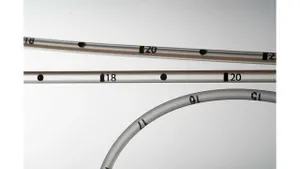Modulus has designs on customers' success
January 1, 1997
|
|
The Aeron chair by Herman Miller won IDSA's design of the year award. Computer-aided engineering helped Modulus designers optimize the chair frame design, select a paint-free PET material and thus remove a step in manufacturing, and still exceed the customer's strength requirements. |
Business as usual at AlliedSignal's design center, where the Modulus Design Group makes camp, is advanced enough to satisfy the most demanding standards. A recent visit confirmed that Modulus, believed to be the only design engineering group in the industry with a trademarked name, is a powerhouse of computer-aided activity. At one workstation, CAE engineer Dawna Schultz conducts an FEA on a power tool housing with a nonlinear package from Ansys. Elsewhere, Craig Scott, a CAD engineer, finishes up a 3-D model in I-deas and prepares it for mold filling analysis.
Most resin suppliers offer design support services; however, in recent years, those services are free only to large customers and, in some cases, must be purchased. Modulus appears to be one of the few that remains available to all customers. So just what does Modulus offer?
What it doesn't offer, you probably don't need. Modulus' services include 3-D solid modeling; analysis of flow, gas, cooling, and warpage; tooling design; FEA for structural, impact, acoustic, fluid, or heat conditions; design optimization; rapid prototyping (both SLS and SLA); and development of composite tooling.
"Our business philosophy is to provide total customer service from concept to part delivery," says Linda Chamberlain, director of research and technology. Her department consists of 80 people who support the three technology functions that make up AlliedSignal's Research & Technology organization—Technical Service, Modulus Design, and New Product Development. "That means supplementing our customers' capabilities from injection molding to a full range of analyses, including structural, mold filling, and cost. Sometimes, it means starting from scratch and completely redesigning the part."
Modulus team members work together to find the optimum design, or redesign, and material for a product. A majority of the time, team members can be found onsite at molders and OEMs helping to train operators and simplify production startups. The group also holds seminars to help customers optimize in-house testing, analysis, molding simulation, and design.
AlliedSignal recently upgraded hardware in the design center with a $600,000 investment in new Hewlett-Packard Unix workstations. As far as software goes, Modulus is equally well stocked with the most recent versions of Cadkey Professional, Catia, I-deas Master Series, Pro/E, Abaqus, Ansys, Hypermesh, Optistruct, Moldflow, MF Warp, C-Flow, C-Warp, and TK Solver. And all systems are linked via local area network for quick communications.
|
The X-Core 5 is a one-piece hollow wheel molded by the lost core process and marketed as a direct replacement to conventional wire spoke wheels. Modulus designers selected an impact-modified nylon 6 with 25 percent glass fiber for strength, stiffness, and long-term durability in this wheelchair application. |
|
Makita worked with Modulus to redesign this fan for a power tool in Capron HPN, a high-flow nylon 6. Cycle times were reduced by 30 percent without sacrificing performance properties. |
Putting all of this design muscle behind some recent products underscores why Chamberlain says, "We've made these investments in Modulus to provide greater customer support early in the design/development cycle." For example, Ford Motor asked its supplier Comcorp to design a plastic accelerator pedal, replacing a steel one, for the 1999 model of a popular vehicle. Both OEM and molder turned to Allied for help, and Modulus came up with a material and a design methodology to do the job.
The material was a 33 percent glass-reinforced nylon 6 (Capron 8233). The methodology is called "proprietary structural design optimization process analysis," and allows Modulus designers to do computer searches for designs with the least volume and highest performance. This led to a C-channel pedal with a reinforcing rib pattern that consists of angled parallel ribs crossed intermittently with diagonal ribs. Ford saved 10 percent on cost and 50 percent on weight.
Makita had been using the same material in a fan for one of its power tools. During a redesign, however, Modulus designers substituted Capron HPN (a high-flow version). The switch cut cycle time by 30 percent and improved aesthetic appearance, all without sacrificing any performance properties. Molder IKKA reported that the material processed well at 15 deg F lower than did the original nylon 6, saving energy as well.
Another automotive customer worked with Modulus to develop an air intake manifold, also for a 1999 vehicle. The part will be vibration welded, so the group performed weld-strength testing to customer specifications.
Herman Miller's Aeron chair, also a Modulus project, represents one of the most stylish applications for Allied's paint-free Petra, a PET grade designed to give great aesthetics in an unpainted condition.
Modulus designers optimized the chair frame structure to the point where its strength exceeded the customer's expectations, according to Chamberlain. She also mentions that Allied is now establishing groups closer to customers. "We now have a Modulus group in Southfield, MI in order to better serve our automotive customers. Recent areas of support include air intake manifolds and accelerator pedals," she notes. It contains four design engineers and two CAE engineers. Another, located in Heverlee, Belgium, serves European customers.
In a related development at Allied, Chamberlain told IMM that the online ordering system announced this year is being prototyped with select customers. Once proven effective, the system will be expanded and will guarantee a 48-hour delivery for 60 percent of Allied's product line; the rest will remain made-to-order. "We're taking the time now to ensure there won't be any security issues at play, and to make sure that orders can be verified and cross checked for accuracy," she notes.
You May Also Like






